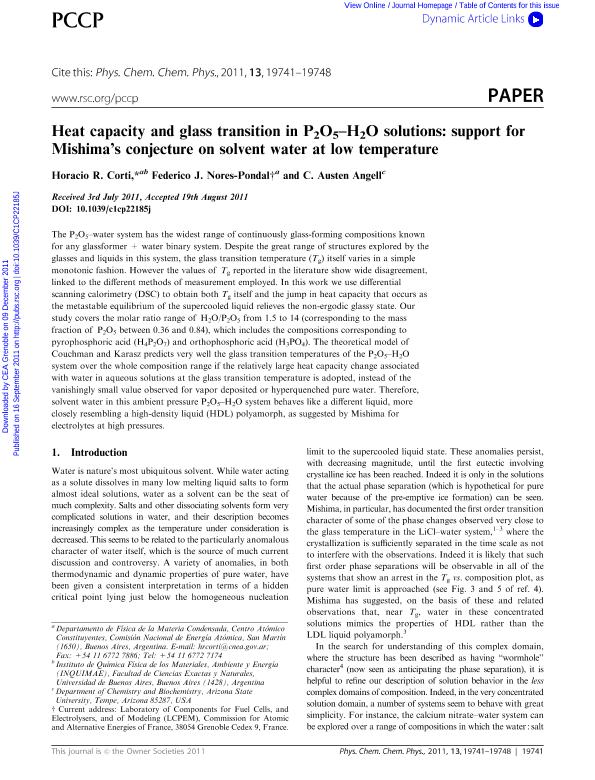Mostrar el registro sencillo del ítem
dc.contributor.author
Corti, Horacio Roberto

dc.contributor.author
Nores Pondal, Federico Jose

dc.contributor.author
Angell, C. Austen
dc.date.available
2023-04-12T13:50:09Z
dc.date.issued
2011-09
dc.identifier.citation
Corti, Horacio Roberto; Nores Pondal, Federico Jose; Angell, C. Austen; Heat capacity and glass transition in P2O5-H 2O solutions: Support for Mishima's conjecture on solvent water at low temperature; Royal Society of Chemistry; Physical Chemistry Chemical Physics; 13; 44; 9-2011; 19741-19748
dc.identifier.issn
1463-9076
dc.identifier.uri
http://hdl.handle.net/11336/193412
dc.description.abstract
The P2O5-water system has the widest range of continuously glass-forming compositions known for any glassformer + water binary system. Despite the great range of structures explored by the glasses and liquids in this system, the glass transition temperature (Tg) itself varies in a simple monotonic fashion. However the values of Tg reported in the literature show wide disagreement, linked to the different methods of measurement employed. In this work we use differential scanning calorimetry (DSC) to obtain both Tg itself and the jump in heat capacity that occurs as the metastable equilibrium of the supercooled liquid relieves the non-ergodic glassy state. Our study covers the molar ratio range of H2O/P2O5 from 1.5 to 14 (corresponding to the mass fraction of P2O5 between 0.36 and 0.84), which includes the compositions corresponding to pyrophosphoric acid (H 4P2O7) and orthophosphoric acid (H 3PO4). The theoretical model of Couchman and Karasz predicts very well the glass transition temperatures of the P2O 5-H2O system over the whole composition range if the relatively large heat capacity change associated with water in aqueous solutions at the glass transition temperature is adopted, instead of the vanishingly small value observed for vapor deposited or hyperquenched pure water. Therefore, solvent water in this ambient pressure P2O5-H 2O system behaves like a different liquid, more closely resembling a high-density liquid (HDL) polyamorph, as suggested by Mishima for electrolytes at high pressures.
dc.format
application/pdf
dc.language.iso
eng
dc.publisher
Royal Society of Chemistry

dc.rights
info:eu-repo/semantics/openAccess
dc.rights.uri
https://creativecommons.org/licenses/by-nc-sa/2.5/ar/
dc.subject
Phosphoric acid
dc.subject
Aqueous solutions
dc.subject
Glass transition
dc.subject
Supercooled
dc.subject.classification
Físico-Química, Ciencia de los Polímeros, Electroquímica

dc.subject.classification
Ciencias Químicas

dc.subject.classification
CIENCIAS NATURALES Y EXACTAS

dc.title
Heat capacity and glass transition in P2O5-H 2O solutions: Support for Mishima's conjecture on solvent water at low temperature
dc.type
info:eu-repo/semantics/article
dc.type
info:ar-repo/semantics/artículo
dc.type
info:eu-repo/semantics/publishedVersion
dc.date.updated
2023-04-11T11:58:26Z
dc.journal.volume
13
dc.journal.number
44
dc.journal.pagination
19741-19748
dc.journal.pais
Reino Unido

dc.journal.ciudad
Cambridge
dc.description.fil
Fil: Corti, Horacio Roberto. Comisión Nacional de Energía Atómica. Centro Atómico Constituyentes; Argentina. Consejo Nacional de Investigaciones Científicas y Técnicas. Oficina de Coordinación Administrativa Ciudad Universitaria. Instituto de Química, Física de los Materiales, Medioambiente y Energía. Universidad de Buenos Aires. Facultad de Ciencias Exactas y Naturales. Instituto de Química, Física de los Materiales, Medioambiente y Energía; Argentina
dc.description.fil
Fil: Nores Pondal, Federico Jose. Comisión Nacional de Energía Atómica. Centro Atómico Constituyentes; Argentina. Consejo Nacional de Investigaciones Científicas y Técnicas; Argentina
dc.description.fil
Fil: Angell, C. Austen. Arizona State University; Estados Unidos
dc.journal.title
Physical Chemistry Chemical Physics

dc.relation.alternativeid
info:eu-repo/semantics/altIdentifier/doi/http://dx.doi.org/10.1039/C1CP22185J
Archivos asociados
